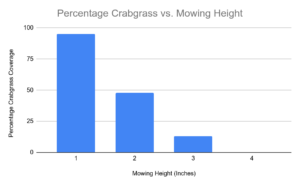Mowing Height for Crabgrass Prevention
go.ncsu.edu/readext?997167
en Español / em Português
El inglés es el idioma de control de esta página. En la medida en que haya algún conflicto entre la traducción al inglés y la traducción, el inglés prevalece.
Al hacer clic en el enlace de traducción se activa un servicio de traducción gratuito para convertir la página al español. Al igual que con cualquier traducción por Internet, la conversión no es sensible al contexto y puede que no traduzca el texto en su significado original. NC State Extension no garantiza la exactitud del texto traducido. Por favor, tenga en cuenta que algunas aplicaciones y/o servicios pueden no funcionar como se espera cuando se traducen.
Português
Inglês é o idioma de controle desta página. Na medida que haja algum conflito entre o texto original em Inglês e a tradução, o Inglês prevalece.
Ao clicar no link de tradução, um serviço gratuito de tradução será ativado para converter a página para o Português. Como em qualquer tradução pela internet, a conversão não é sensivel ao contexto e pode não ocorrer a tradução para o significado orginal. O serviço de Extensão da Carolina do Norte (NC State Extension) não garante a exatidão do texto traduzido. Por favor, observe que algumas funções ou serviços podem não funcionar como esperado após a tradução.
English
English is the controlling language of this page. To the extent there is any conflict between the English text and the translation, English controls.
Clicking on the translation link activates a free translation service to convert the page to Spanish. As with any Internet translation, the conversion is not context-sensitive and may not translate the text to its original meaning. NC State Extension does not guarantee the accuracy of the translated text. Please note that some applications and/or services may not function as expected when translated.
Collapse ▲Canadian rock band Rush released the album Permanent Waves in 1980. The second track on that album is “Freewill”. This song contains the line “If you choose not to decide, you still have made a choice”.
I make this odd introduction because right now there are people expending vast amounts of time, energy, and resources on their lawns. They are performing rituals and making sacrifices to the turf gods so their lawns will be the envy of all.
However, there is one lawn maintenance practice that, once you decide (or you choose not to decide), will be the biggest determining factor of your lawn’s success. This all important practice is mowing height. Mower blade height is the single most important decision for the health of a tall fescue lawn.
During the first few mowings in the spring, the blade height can be reduced to 3 inches, but after that, it is time to raise that blade to 4 inches. Many homeowners mow their lawns shorter than recommended. This close mowing may cause scalping and induce stress, making tall fescue less able to crowd out crabgrass and other weed species.
A healthy, actively growing turf is essential to combat weeds. A healthy lawn has no room for weeds. A thick tall fescue sod is a very competitive environment for most weeds.
To demonstrate the importance of mowing height, a field experiment was conducted at Lake Wheeler Turfgrass Field Lab in Raleigh. The goal was to demonstrate the effect of tall fescue mowing height on crabgrass incidence.
This experiment evaluated mowing height. The plots were mowed at either 1, 2, 3, or 4 inches. This experiment began on April 15th when soil temperatures reached an optimum for crabgrass emergence.

Chart Showing Results of Mowing Height Demonstration
The plots were evaluated monthly for crabgrass during the growing season. By mid-September, 1, 2, 3, or 4 inch tall fescue mowing heights resulted in 95%, 48%, 13%, and 0% crabgrass cover, respectively. This demonstrates that maintaining tall fescue at 4 inches provides effective crabgrass suppression in tall fescue.
One of the simplest and most economical ways to ensure your tall fescue is healthy and actively growing is to mow at the proper height and frequency. Nothing else can make up for tall fescue that is mowed too short. It is called tall fescue for a reason.
For answers to your agriculture questions, call theN.C. Cooperative Extension, Caldwell County Center at 828-757-1290 or visit us online any time.
— Seth Nagy is the N.C. Cooperative Extension, Caldwell County Center director. The N.C. Cooperative Extension, Caldwell County Center, 120 Hospital Ave. NE, #1 in Lenoir, provides access to resources of N.C. State University and N.C. A&T State University through educational programs and publications.




